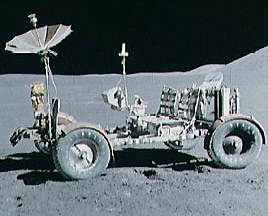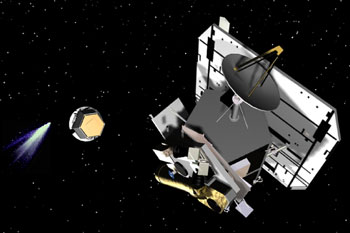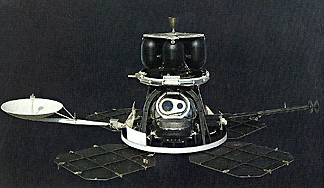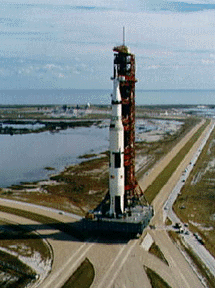View of Apollo 14 on its way to launch pad
NASA
Apollo 14
Astronauts Alan Shepard, Stuart Roosa, and Edgar Mitchel were launched from Earth on Jan. 31, 1971 aboard Apollo 14. Their mission was to land on the Moon and carry out experiments on it surface, similar to those of Apollo 12.
The Apollo 14 lunar module touched down on an 8 degree slope in Fra Mauro, which had been the destination of the ill-fated Apollo 13 spacecraft. Astronauts Shepard and Mitchell stayed on the lunar surface for a day and a half, performing two space walks and making use of a newly designed handcart. The handcart made it easier for them to transport equipment and collect larger amouts of soil and rock.
The astronauts also spent time searching for Cone Crater, which their maps had shown them should be nearby. Time forced them to give up their search while just 30 meters from the crater's rim. Apollo 14 safely returned to Earth on Feb. 9, 1971.
You might also be interested in:

Apollo 12 was launched on Nov. 14, 1969, surviving a lightning strike which temporarily shut down many systems, and arrived at the Moon three days later. Astronauts Charles Conrad and Alan Bean descended
...more
The Hubble Space Telescope (HST) was one of the most important exploration tools of the past two decades, and will continue to serve as a great resource well into the new millennium. The HST found numerous
...more
Driven by a recent surge in space research, the Apollo program hoped to add to the accomplishments of the Lunar Orbiter and Surveyor missions of the late 1960's. Apollo 11 was the name of the first mission
...more
Apollo 15 marked the start of a new series of missions from the Apollo space program, each capable of exploring more lunar terrain than ever before. Launched on July 26, 1971, Apollo 15 reached the Moon
...more
NASA chose Deep Impact to be part of a special series called the Discovery Program on July 7, 1999. The Discovery program specializes in low-cost, scientific projects. In May 2001, Deep Impact was given
...more
The Galileo spacecraft was launched on October 19, 1989. Galileo had two parts: an orbiter and a descent probe that parachuted into Jupiter's atmosphere. Galileo's main mission was to explore Jupiter and
...more
During 1966 through 1967, five Lunar Orbiter spacecrafts were launched, with the purpose of mapping the Moon's surface in preparation for the Apollo and Surveyor landings. All five missions were successful.
...more















